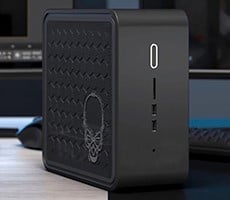Shuttle's SB81P XPC
The FB81 motherboard used in the Shuttle SB81P XPC is equipped with an Award / Phoenix v6.0 BIOS derivative, like most of the other motherboards shipping today. Shuttle has added a few additional tweaking options, however, that gives the SB81P XPC some fairly unique features and capabilities...
|
The majority of the SB81P's BIOS menus contain options that are commonly found on a myriad of other products. The Standard CMOS Features, Advanced BIOS Features, and Advanced Chipset Features menus are home to some of the more common features for enabling or disabling integrated peripherals assigning the boot order, and setting the time and date, among other things. The PC Health section is used to monitor temperatures and voltages, as well as tweak the "Smart Fan" settings.
The options available in the PC Health menu have actually raised a few eyebrows at some other popular sites. The problem stems from the way the "CPU Temp Tag" option affects the throttling of the SB81P's cooling fans. The CPU Temp tag option "tells" the smart fans to spin faster, once the designated temperature is reached. But the fans don't simply throttle between a high and low speed. The fans begin to spin incrementally faster at higher temperatures, until the CPU hits a peak temperature of 80 degrees Celsius, at which point the fans spin as fast as possible. The problem is, high-end Pentium 4's (like the 560 and 3.4GHz EE) begin to throttle their clock speeds once a core temperature of about 70 degrees C is reached. This causes the processor to throttle down to lower temperatures, which lowers the performance of the system. Compounding the problem is the fact that Shuttle sets the default temp tag to 50 degrees C (with the latest BIOS), which is a bit too high. To properly handle the thermal demands of a high-end Pentium 4 without temperatures getting too high, Shuttle needs to release a new BIOS that lowers the peak temperature to about 65-70 degrees C, and sets the CPU Temp Tag to the lowest option available, currently 30 degrees C, so the fans begin to spin faster at a lower temperature. Another simple workaround is to shut off the smart fan feature altogether and set the fans to spin faster constantly, but this increases the SB81P's noise level significantly. In fact, with all of the fans spinning at their maximum, the system sounds very much like a hair dryer. Shuttle's soon to be released XPC tools software can also be used to create a custom fan speed profile to solve the problem, but this likely won't be necessary. A future BIOS update should be able to address this issue.
We should mention that we did NOT have any problems with throttling throughout our testing, for a few reasons. First, all of the testing was done in a well air-conditioned room, that barely breaks 70 degrees F. We also used an engineering sample CPU, rated for 3.6GHz, clocked at only 3.4GHz. And we set the CPU Temp Tag to 30 degrees C. By setting the CPU Temp tag to 30 degrees C, and testing the system with a CPU clocked below its rated frequency in a well cooled room, our processor never hit any excessively high temperatures.
|
In the Frequency / Voltage Control menu is where users will find all of the SB81P's various overclocking options. Using the options available under this menu, users can alter their processor's bus speed between 100 and 355MHz, in 1MHz increments, and the PCI Express / PCI clock can be set to sync with the CPU bus, or be locked at 100MHz / 33MHz. Processor, DRAM, and Northbridge voltages are also user configurable. CPU voltages between 0.825 and 1.5875V (in 0.0125v increments) are available, DRAM voltages range from 2.7v to 2.9v (in .1v increments), and the Northbridge voltages between 1.6v and 1.8, in .1v increments are available.








